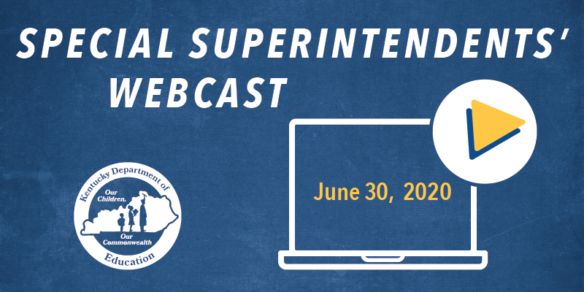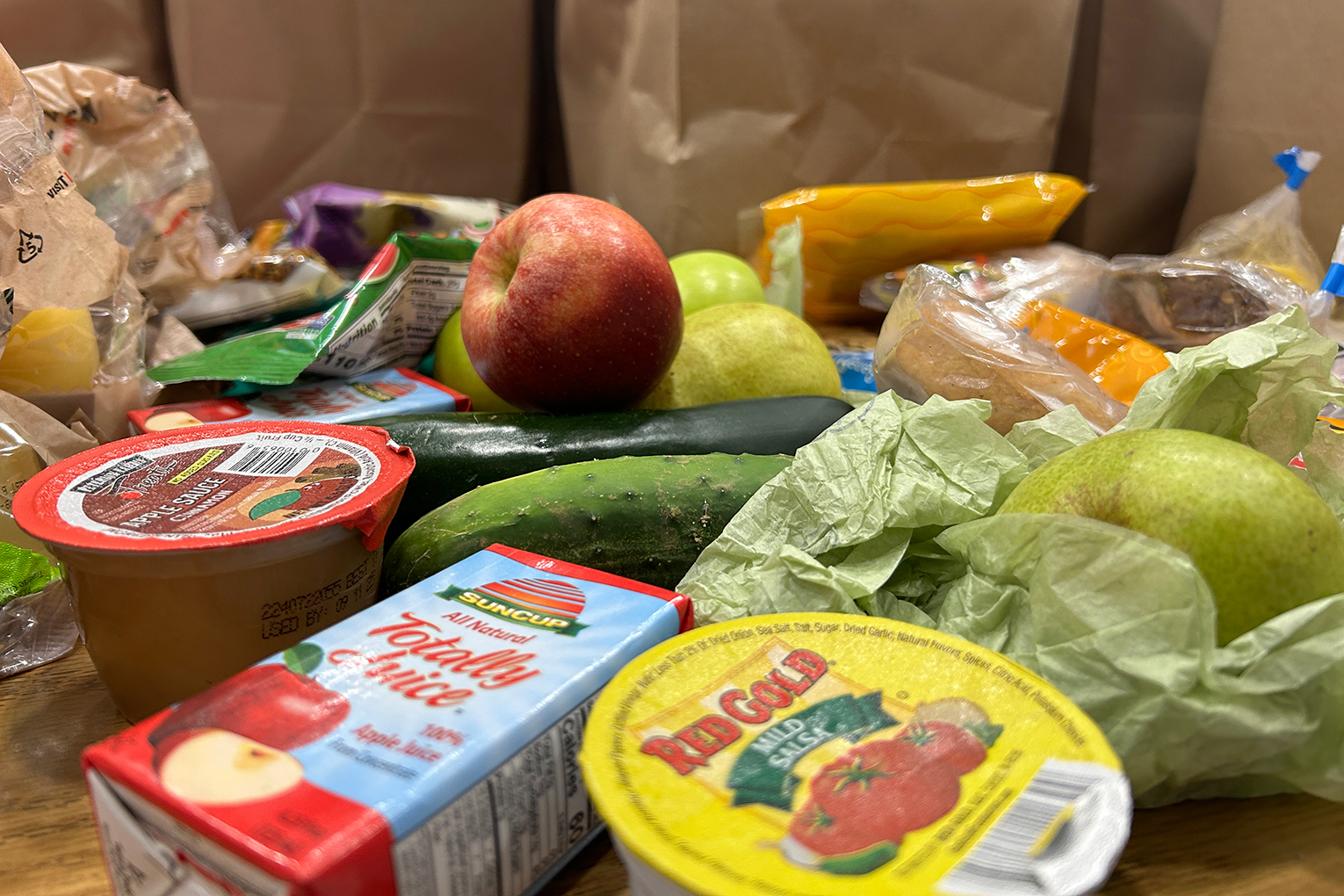
- Mask rules, logistics of 6-foot distancing draw more superintendent questions.
- Kentucky DPH to send schools 12,500 no-touch thermometers.
By Jim Gaines
jim.gaines@education.ky.gov
The vital importance of wearing masks, staying 6 feet apart and tailoring ways for local school districts to meet those goals dominated the Special Superintendents’ Webcast on June 30.
Superintendents questioned whether students who refuse to wear masks or have their temperature checked could be refused bus transportation. Kentucky Department of Education (KDE) officials urged persuasion – providing masks, explaining their importance, contacting parents, etc. – rather than punitive measures.
“We know it’s going to be temporary. It’s not something we’ll have to do the rest of our lives, but it’s something we’ve got to do right now,” Interim Education Commissioner Kevin C. Brown said.
If students still won’t comply, districts “may need to look for alternate means,” including disciplinary action, KDE Interim General Counsel Todd Allen said. But that should be a last resort, he said.
Brown and Dr. Connie Gayle White, deputy commissioner of the Kentucky Department for Public Health, likened mask guidelines to dress codes. People aren’t divided on the expectation that everyone will wear shirts and shoes, but masks are still controversial, Brown said. He believes acceptance will grow as COVID-19 cases increase.
Teachers, school staff and superintendents should be role models for getting people used to wearing masks and other personal protective equipment (PPE), White said. Wearing masks and staying 6 feet apart won’t just protect students, but also will help prevent them from infecting their families or school employees, who might die from COVID-19, she said.
People with respiratory problems and special needs students are the ones most likely to need a medical exemption from wearing a mask, but their situations are so diverse they should be dealt with case by case, White said. She said families will need to contact their healthcare providers for advice.
Brown repeated advice from previous webcasts that students should be kept at least 6 feet apart whenever possible. They need to wear masks whenever they’re closer than that or when they’re moving around. Flexibility may come from scheduling some classes in larger rooms or creating break periods when students can be separated so masks can be taken off for a while, he said.
“Districts are going to have to weigh the pros and cons of all those scenarios,” Brown said.
Free Thermometers
KDE Associate Commissioner Robin Kinney said school districts will be allocated 12,500 no-touch thermometers. They can be picked up at regional distribution centers at no charge, she said. The number each district receives will be “loosely based” on its number of schools and buses, Kinney said. More information will be sent to each district.
“We know that this amount won’t cover all your needs, but it’s a great way to get us started,” Kinney said.
Reimbursement for more thermometers and other protective equipment may be available from the Federal Emergency Management Agency (FEMA).
Expenses related to COVID-19 preparations, response and recovery are eligible from Jan. 20, 2020, onward, said Tracy Doyle from Kentucky Emergency Management in the June 16 superintendents’ webcast. Documenting expenses carefully and specifying their connection with COVID-19 measures is crucial, she said.
Reopening Standards
KDE will have issued 16 guidance documents on reopening and other issues related to COVID-19 by the time the 2020-2021 school year starts, Brown said. Most of them already are out, and the rest are coming in the next few weeks, ending with standards for performance-based instruction, he said.
The “flagship document” is Healthy At School, which came out on June 24, Brown said. In addition to KDE’s guidance, the Kentucky Association of School Superintendents (KASS) is providing an online repository for districts to share reopening plans and related information with each other, said Jim Flynn, KASS executive director. Flynn said he will send out periodic updates, helping districts access the information easily.
Student Transportation
On June 25, KDE released guidance on transporting students for the upcoming year. School traffic patterns are likely to change substantially as many parents choose to drive children to school or have them walk instead of taking the bus, said Kay Kennedy of KDE’s Office of Finance and Operations.
Schools may need to make many adjustments, such as separating bell times so groups of students won’t mix and unloading buses in stages, said Elisa Hanley, also with the Office of Finance and Operations. If students do ride the bus, they generally will need to wear masks, undergo temperature screenings and use assigned seats to maintain distance.
“The number of students on the bus is dependent on the prevalence of COVID-19 in the community,” Hanley said.
Students in 1st grade or above need to wear masks on the bus unless they have a medical waiver, Hanley said. Districts should ask parents to get their kids used to wearing masks now so they will be comfortable with it when they need to wear one for school, she said.
Riders should be given hand sanitizer from a dispenser as they board the bus, Hanley said, and buses should be sanitized at the end of each route.
“This will increase the time needed if buses are doing double runs,” she said.
More Guidance
Guidance on reopening facilities and the associated logistics came out on June 29. It deals with the mechanics of sanitizing schools and choreographing student movements to keep risks of infection down. Kennedy said it is important to continue drills for other emergencies, such as a fire or tornado, but to do so with COVID-19 precautions in place.
Also on June 29, KDE released guidance on reopening career and technical education facilities, allowing students to complete industry certifications and lab-based coursework.
The latest guidance is to allow a return to labs and classrooms on July 1, with graduating seniors given priority, said Tom Thompson of the KDE Office of Career and Technical Education and Student Transition. Districts should work with local health departments on reopening plans, but also mind other guidance including Healthy At School, he said.
Superintendent Questions
During a question-and-answer session at the end of the webcast, one superintendent asked if the limit of three “emergency days” school staff can take off is waived in the event they are quarantined. The three-day limit is set by law, and the waiver in Senate Bill 177 ended with the old school year, KDE Interim General Counsel Allen said. But local school boards can grant extra sick days, he said.
“Emergency days are different,” Allen said.
Asked whether schools could livestream classes for students at home, Brown referred to the June 25 memo waiving the limit on non-traditional instruction days for the upcoming year. Attendance numbers also have been temporarily decoupled from school funding to allow more remote teaching, he said. The Kentucky Board of Education may vote July 10 on further parameters for those issues, Brown said.
Superintendent Search
The names of the final four candidates for wishing to become Kentucky’s next commissioner of education should be announced this week, said Jennifer Ginn, assistant director of KDE’s Division of Communications. The state Board of Education could make its final choice on July 7 or a few days after that, she said. A new commissioner is likely to start work around the beginning of August.
MORE INFO …
- June 30 Special Superintendents’ Webcast
- Kentucky Department for Public Health’s COVID-19 webpage
- KDE’s COVID-19 webpage
- COVID-19 Hotline (800) 722-5725




Leave A Comment